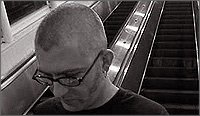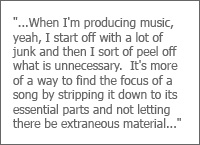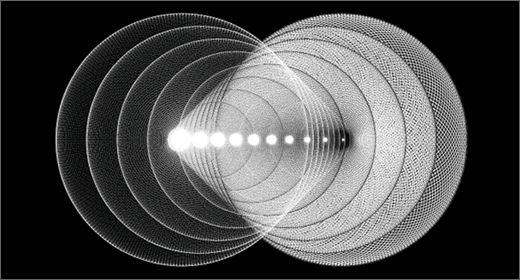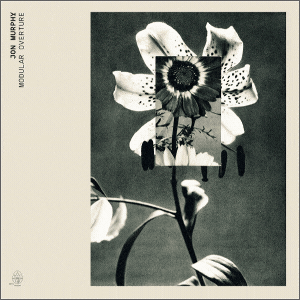
(11.12.06) JEFF MCILWAIN performed twice at the 2006 Decibel Festival: once, on Friday night as part of the Headfuk showcase; and on the following day, as the headliner for the Robotspeak technical showcase. He offered two very different sets: one, a banging, four on the floor techno show that filled the room with bubbling beats and twanging rhythms; the second was comprised slowly evolving sounds, ambient textures that shyly refused to commit to melodic structure. Both were highly divergent from his set at last year’s Ambient Showcase where he merged field recordings with blissful tone poetry and microscopic beat manipulation. Lusine is, as one will discover rather quickly while listening to the body of work, difficult to pin down. McIlwain is a restless composer, always seeking new influences and new sounds.
Following his show at the Robotspeak program, Igloo managed to corner McIlwain long enough to get him to answer a few questions.
Mark Teppo / Igloo :: Last night, I noticed that at the end of your show, your entire set-up fit in a backpack. Pack up, and out the door. And then, today for the Robotspeak set, you had a desk full of gear. The laptop can, naturally, hold more than a show’s worth of music but does the pre-show process of picking and choosing hardware focus or limit the creative aspect of the set you’re going to do?
Jeff / Lusine :: There’s definitely room for creativity. As far as the differences between a hardware set and a software set, the approach is almost exactly the same. The sequencer is actually controlling some of the hardware externally. The effects processor is external. The mixer is external. It’s the exact same thing as what can be done on the laptop. It’s just a matter of presentation, I think.
Igloo :: During the Q & A following the Robotspeak, you were asked about one of the compressors that you use and you talked about the sounds you get from it. Regardless of the replication of instruments and equipment in either an external or internal setting, are there differences in sound between hardware and software?
Jeff :: That’s one plus [of the hardware set]. Like the DL-4 — they might have a plug-in for it — the DL-4 does a lot of really cool stuff that I couldn’t really get internally. And like the ARP. You can’t really tweak something like that internally. The ARP plugin is pretty good, but it’s just not quite the same.
Igloo :: When you’re building songs, say a couple of tracks for a 12″, how much consideration do you give to hardware vs software when you’re thinking about the sounds?
Jeff :: Some, definitely. If I’m looking for something really warm and bassy — or maybe an interesting crackly sample — I might record it in. Usually it’s sample-based. I don’t do all that much hardware sequencing. I usually take it in pretty quickly. I generate sounds with hardware, and I usually have a pretty good idea of what sort of sound I want to go with before I start.
Igloo :: How does your compositional process work? You use field recordings in some of your pieces. Do you establish that need ahead of time — “oh, I need birds” — and go off and get those recordings? Or do they flow in later?
Jeff :: I do use them, but they’re usually on the periphery, not the central focus of the song. If I’m doing an ambient song, then it has a lot more to do with the sounds I’ll use. But, a lot of the time, musically I have in mind something that is influenced by what I’m hearing — “oh, I want to do a song in this style.” The sound collecting and stuff like that isn’t necessarily focused towards one song. I’ll do a lot of field recordings and put them in a bank of sounds. I’ll add to it, and when I need something I can get it from the bank. But it’s not like I have a song that I’m working on that needs the sound of children laughing or something like that.
Igloo :: A lot of electronic music is built from layers: the artist will start with something small or insignificant and then add more and more texture and rhythms and what-not on top. They’ll keep on stacking sounds until they’ve got something that works. I understand that you’re more prone to take things out as part of that final mixing.
Jeff :: [Laughs] Yeah. I mean, when you hear the final product, there’s definitely a lot of layering going on. When I’m producing music, yeah, I start off with a lot of junk and then I sort of peel off what is unnecessary. It’s more of a way to find the focus of a song by stripping it down to its essential parts and not letting there be extraneous material. When you do hear the finished song, a lot of time it is adding layers and taking layers out, but they are the ones I felt should be there.
Igloo :: Are they loops? I ask, because I am completely ignorant about how these things work.
Jeff :: Yeah, some of them are. Some of them are long phrases that I’m cutting pieces out of and putting in here and there. A lot of it is loops that I’ve worked on beforehand and when I bring it into Cubase, a lot of stuff gets added in and then I edit it down to what sounds good.
Igloo :: What drives the process at this point? Once you have an idea of what the song is, what is it that pushes you toward the final product? Is it emotional triggers? Certain sound arrangements?
Jeff :: Yeah, usually you’ll have a phrase and you want to add other elements that go along with it, like, rhythmically. If you already have something in a particular frequency range or a really long sample and you need . . . [Laughs] . . . I’m not sure how to answer this question. Yeah, I’m definitely trying to find something that goes along with the phrasing but maybe in a different frequency spectrum so that it complements the rest of the song rhythmically but it doesn’t necessarily muddy it up by being in the same field of sound.
Igloo :: I was looking at two of your recent releases: the Emerald EP (from Ghostly) and the disc you did for Hymen’s Travel Sickness set (as Lusine icl). If I didn’t know better, I’d say these were done by two different people. They’re vastly different in their composition and selection of material.

Jeff :: In that particular example, you’ve picked two releases where that distinction is probably a little more telling. Travel Sickness: those songs I wrote three years ago. Emerald: I wrote those four months ago. [Laughs] It makes a big difference. I was in a completely different place three or four years ago. I think the Travel Sickness stuff sounds closer to what I was doing for Iron City (on Hymen, in 2002) and A PseudoSteady State (on U-Cover, in 2000).
Igloo :: Is the Emerald EP an evolution then, a sound that is more fitting for a label like Ghostly?
Jeff :: Yeah, but I’m still doing some stuff for Hymen. You might say it is similar to Travel Sickness, but it is more ambient, more like . . . I don’t know . . . the rhythms are different than what I used to do — not nearly as programmed — it’s going to be much more like the people I’m interested in right now, like Susumu Yokota and Biosphere. Where it is much more stretched out. Stuff like Fennesz. Where it’s not so programmed as the other stuff. And I want it to be separate from the stuff I’m doing for Ghostly which is a lot more structured.
Igloo :: How do audiences approach those sorts of distinctions? Do you think electronic audiences have a better ability to cross genres than others? Would your Ghostly fans be freaked out by what you’ve done for Hymen and vice versa?
Jeff :: Honestly, the fans I care about are the ones that are concerned if the music is good. The fans that I’m not really concerned about liking some of what I do and liking other things are the people who just want to hear electro or techno, for example. I’m not really going to cater to that, because those fans are going to get sick of it. A year from now or so, they’re going to want to hear something else. So, if you try to cater to fans that are only into one thing, it’s not a very healthy way to approach music.
But, at the same time, I am considering doing another alias for straight up dance music, that’s much more minimal. It’s easier to book or play a show when they know what they are getting.
Igloo :: Electronic music seems to have a huge array of musical styles, and you can swing from genre to genre very easily. Does that sort of wide availability of styles inform your evolution as an artist?
Jeff :: Oh, definitely. If I listened to just one thing, I’d be much more narrow-minded. It’s definitely inspirational to be able to jump to different genres. It’s a different feeling altogether. When you get older, I think, you start being able to appreciate all of them, in different ways.
Igloo :: You’ve had some experience scoring for film. How does working in that environment effect your creative process?
Jeff :: It’s really great, actually. I just finished the score for this film Snow Angels. I collaborated on it with a friend of mine and it was really awesome. Just to be able to take the emotion of a film and add to it — not too much — but just enough to elevate the scene to where it needs to be. To be able to work on someone’s work like that is, yeah, fun.
Igloo :: Is it the same sort of creative venture as working with someone else’s music?
Jeff :: Well, I’m a lot more picky when it comes to that. [Laughs] My friend David — we worked on the score together — that was different because I can collaborate with him. There are only a couple of people that our musical tastes are close enough that we’ll be able to work together. I try to avoid collaborations because I know they’re going to hate me before we’re halfway through. But, when you’re working on film, they’re in a completely different area altogether. A lot of time the director will say, “No, the music needs to be more like this.” But it’s up to you to decide what more like this means.
Igloo :: How much music do you generate for film? Lots of minute long incidental pieces or longer thematic stuff that is broken up as necessary? Like leitmotifs and the like.
Jeff :: On this project, we had to have the music where we really liked it before we sent it to the director. To us, it was a finished project because, otherwise, it’s going to give them the wrong impression. They’re going to feel like what you sent them is a final thing. A lot of times directors don’t have the musical knowledge to know what can be embellished, they kind of get a feeling from it. They’re watching the film; they’re not necessarily listening to the music. The music is supposed to enhance what they’re watching. If it doesn’t, then they come back and say that it doesn’t work. And that’s confuses you because you know it could be better than it was. That’s why we really only want to send in a finished product.
Igloo :: Do you work from a rough cut of the film?
Jeff :: Yeah, revision one. And they’ll send another edit. But it doesn’t really matter. They know what kind of mood they want. Once they like what we have, then we just wait until the final cut. Then we edit it in.
Igloo :: Finally, on the subject of sampling earlier, you mentioned that you sample from the radio.
Jeff :: Sure. Anything. Hip-hop stations are great because they have the best beats, the best kicks. [Laughs] They’ve spent so much time on them. I have no problem with sampling them. If it’s not a whole phrase or a whole loop, you can totally just take that little kick and make something completely different out of it. Even just incidental things on the radio, just take them from the wrong loop point and making something else. It’s like a really good sample library. To me, it’s a lot better than buying a sample CD — that can be useful too — but you can get a lot of grit and weirdness when you sample from the radio.























